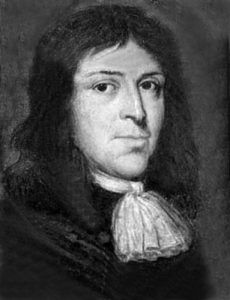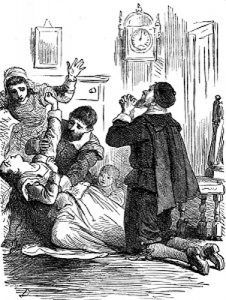In the meantime, many of the villagers continued to hope to separate their church parish from the Church of Salem and began to search for an ordained minister. In June 1689 the Reverend Samuel Parris came to the village and began his ministerial duties. On November 19, 1689, the Salem Village church charter was finally signed and the Reverend Samuel Parris became Salem Village’s first ordained minister. Salem Village now had a true church. This only intensified the Putnam-Porter conflict.
The differing beliefs of the two factions, along with numerous land feuds continued to divide the village. The division increased on October 16, 1691, when the Porter faction took control of the village committee from the Putnams and their friends. Some of these new selectmen included Daniel Andrew, the son-in-law of John Porter, Sr.; Joseph Hutchinson, one of the sawmill operators responsible for flooding the Putnams’ farms; Francis Nurse, a village farmer who had been involved in a bitter boundary dispute with Nathaniel Putnam; and Joseph Porter, Thomas Porter, Jr’s half-brother. The new committee quickly voted down a tax levy that would have raised revenue to pay the salary of Reverend Parris. This naturally infuriated Thomas Putnam, Jr. and his followers. Embittered, the minister avenged this refusal by proclaiming in his sermons that a conspiracy against the church had been hatched within the village. He even went so far as to assert that the Devil had taken possession of some of the villagers.
In addition to the Porters, Thomas Putnam, Jr. also had a lengthy list of other perceived enemies, including the Howe, Towne, Hobbs, and Wildes families of Topsfield, with whom he had engaged in land disputes. Another was John Proctor, who had gained a license for a tavern with the stipulation that he could not sell liquor to locals. This made Proctor’s tavern a rendezvous point for “outsiders.” It was also in competition with his ally, Nathaniel Ingersoll. Other enemies included Daniel Andrews and Philip English who were closely associated with the Porter family.
It was against this background that the witch hysteria began in early 1692.
The first of the “afflicted girls” was none other than the Reverend Samuel Parris’ daughter, Elizabeth Parris, quickly followed by her cousin, Abigail Williams, who also lived in the Parris household. Both began having fits and acting strangely. After several ministers and a doctor looked at the girls, it was decided their afflictions could only be caused by witchcraft. Before long, other young members of the community also began to have fits including Thomas Putnam’s daughter Ann Putnam, Jr.; his niece, Mary Walcott, and a servant girl who lived in the Putnam household named Mercy Lewis. Since the sufferers of witchcraft were believed to be the victims of a crime, the community set out to find the perpetrators. On February 29, 1692, under intense adult questioning, Elizabeth Parris and Abigail Williams named Sarah Good, Sarah Osborne, and Tituba as their tormentors. These five “afflicted girls” would become the most fervent of the accusers. Furthermore, the majority of those who were accused were enemies of the Putnams.
By the end of May 1692, more than 150 “witches” had been jailed and by September, 19 people had refused to confess and were hanged, and another had been pressed to death for refusing to make a plea. By October 1692; however, cooler heads began to prevail and the court disallowed “spectral evidence.” The affair wouldn’t end until May 1693, when all of the accused were finally released from jail.
Putnam Family Members Involved in the Salem Witchcraft Hysteria:
Ann Putnam, Jr. (1679-1716) – Twelve-year-old Ann Putnam, Jr. played a crucial role in the witchcraft trials of 1692 as one of the first three “afflicted” children. Born on October 18, 1679, in Salem Village, Massachusetts, she was the eldest child of Thomas Putnam, Jr. and Ann Carr Putnam. She was friends Elizabeth Parris and Abigail Williams and in March 1692, she too proclaimed to be afflicted. Her mother, Ann Carr Putnam, a fearful woman who was still mourning the death of an infant daughter, also would later claim that she had been attacked by witches. See article HERE.
Ann Carr Putnam, Sr. (1661-1699) – The wife of Thomas Putnam, Jr and the mother of Ann Putnam, Jr., Ann, Sr. would also be involved in the witch trial hysteria, allegedly having fits of her own and making accusations against suspected “witches.” She was born on June 15, 1661, to George and Elizabeth Oliver Carr in Salisbury, Massachusetts. She would later move to Salem Village with her sister, Mary Carr Bailey. She married Thomas Putnam, Jr. on November 25, 1678, and the couple would eventually have 12 children. Described as a fearful woman with a highly sensitive temperament, she was seeming the opposite of her decisive and obstinate husband. Her mental health declined after her sister, Mary’s three children died in quick succession, followed shortly by Mary herself in 1688.
Also having an effect on her was when her wealthy father, George Carr, who owned ship works and milling businesses in Salisbury, died and she was disinherited. Instead, the estate was given to her brothers. Though she tried to sue for her share of the inheritance, she was unsuccessful. In 1689, she lost an infant daughter further shaking her mental stability. After her daughter, Ann Putnam, Jr. began having fits and accusing people of witchcraft, Ann Carr Putnam soon joined her in both actions and accusations. Shortly afterward, her brother-in-law, Joseph Putnam, specifically told her that if her lies about witchcraft touched anyone in his family, she would pay for it. Joseph would then keep guns loaded and horses saddled throughout the period of the trials to facilitate his family’s escape if any of them were accused. None of them were. However, Ann, Sr. would accuse Martha Corey, Rebecca Towne Nurse, Bridget Playfer Bishop, and John Willard, who would all be executed for witchcraft. She would also testify against Sarah Towne Cloyce, William Hobbs, and Elizabeth Walker Cary. Her husband, Thomas Putnam, Jr. died on May 24, 1699, in Salem Village. Just two weeks later, on June 8th, Ann also passed away. Their daughter, Ann Putnam, Jr., was left to bring up their younger children.
Edward Putnam (1654-1747) – A third-generation member of Salem Village, Edward Putnam was born to Thomas Putnam and Ann Holyoke on July 4, 1654, in Salem Village, Massachusetts. He grew up to marry Mary Hale on June 14, 1681, and the couple would have ten children. Edward had a farm in what is now Middleton, Massachusetts. On December 3, 1690, he became the second deacon for the Salem Village church. During the Salem Witch Trials, Edward, along with other members of his family brought charges and testified against many innocent people. He often participated in examinations of both the accused and the “afflicted” in order to determine whether or not they were truthful in their declarations. If he was convinced, he would then follow through with complaints and testimony. Of complaints filed, his name would be on those of Martha Corey, Sarah, and Dorcas Good, Mary Ireson, Rebecca Nurse, Sarah Warren Prince Osborne. He would also testify against the Reverend George Burroughs, Mary Eastey, Elizabeth Bassett Proctor, John Willard, and Sarah Smith Buckley. Years later, Edward would become the historian and genealogist of the family, writing an account in 1733. He died on March 10, 1747, in Salem Village and was buried at the Burying Point Cemetery in Salem, Massachusetts.
Hannah Cutler Putnam (1655-after 1722) The wife of John Putnam, the son of Nathaniel Putnam, Hannah was born to Samuel and Elizabeth Cutler on December 6, 1655, in Salem Village, Massachusetts. She grew up to marry John Putnam on December 2, 1678, and the couple would have 15 children. During the trial of Rebecca Nurse, Mary Easty, and Sarah Cloyce, she and her husband would give a deposition blaming the death of their eight-week-old child, who appeared to be having fits, on witchcraft. Hannah’s husband would die in 1722 while she was still living. It is unknown when Hannah died.


